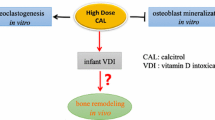Abstract
It has been reported that some hypoparathyroid patients with magnesium deficiency showed altered responses to vitamin D treatment. In the same way,in vitro bone studies have demonstrated the existence of a decrease in the 1,25-dihydroxyvitamin D3-induced resorption in bone as a result of magnesium deficiency. These findings suggest some kind of alteration in the 1,25(OH)2D3 in bone in magnesium deficiency. In the present work, using a binding assay based on the 1,25(OH)2D3 and3H-1,25(OH)2D3 competition for the hormone binding sites in rat calvaria homogenates, a significant decrease in the number of 1,25(OH)2D3 specific binding sites has been found in calvaria incubated in magnesium-deficient medium compared to magnesium-replete ones. Alterations in the hormone-receptor affinity were not found. These results suggest that an alteration in the 1,25(OH)2D3 action on magnesium-deficient bone could be due, at least in part, to a decrease in the number of available vitamin D receptors in bone cells.
Resumen
Se ha descrito que algunos pacientes hipoparatiroideos deficientes en magnesio mostraban una respuesta alterada al tratamiento con la vitamina D. Además, en estudiosin vitro con cultivos óseos deficientes en magnesio, se ha observado descenso en los procesos de resorción del hueso inducida por la 1,25-dihidroxi-vitamina D3 (1,25(OH)2D3), sugiriendo una posible alteración sobre las acciones de la 1,25(OH)2D3 en los huesos deficientes en magnesio. En este trabajo, se ha encontrado un descenso significativo en el número de sitios de unión de la 1,25(OH)2D3 en calotas deficientes en magnesio frente a calotas repletas en Mg2+, mediante un ensayo de competición entre la hormona fría y la hormona marcada radioactivamente. Sin embargo, no se encontraron alteraciones en la afinidad de la hormona por su receptor. Estos resultados sugieren que las alteraciones observadas en la acción de la 1,25(OH)2D3 en huesos deficientes en magnesio podrían ser debidas, al menos en parte, a un descenso en el número de receptores disponibles para la 1,25(OH)2D3 en células óseas.
Similar content being viewed by others
References
Biggers, J. D., Gwatkin, R. B. and Heyner, S. (1961):Exp. Cell. Res.,25, 41–58.
Darwish, H. M. and DeLuca, H. F. (1996):Prog. Nucleic Acid. Res. Mol. Biol.,53, 321–344.
Ducreaux, M., Messing, B., De Vernejoul, M. C., Buhnik, Y., Miravet, L. and Rambaud, J. C. (1991):Gastroenterol. Clin. Biol.,15, 805–811.
Freake, H. C. and McCarthy, D. M. (1984):Cancer Res.,44, 3627–3631.
Johannesson, A. J. and Raisz, L. G. (1983):Endocrinology,113, 2294–2298.
Lemay, J. and Gascon-Barré, M. (1992):Endocrinology,130, 2767–2777.
Lifshitz, F., Harrison, H. C. and Harrison, H. E. (1967):Proc. Soc. Exp. Biol. Med.,125, 472–476.
Medalle, R., Waterhouse, C. and Hahn, T. J. (1976):Am. J. Clin. Nutr.,29, 854–858.
Norman, A. W., Roth, J. and Orci, L. (1982):Endocrinol. Rev.,3, 331–366.
Municio, M. J., Traba, M. L. and De la Piedra, C. (1995):Horm. Metab. Res.,27, 296–299.
Pike, J. W. (1991):Ann. Rev. Nutr.,11, 189–216.
Pan, L. C. and Price, P. A. (1984):J. Biol. Chem.,259, 5844–5847.
Risco, F. and Traba, M. L. (1992):Magnesium Res.,5, 5–14.
Rosler, A. and Rabinowitz, D. (1973):Lancet,1, 803–805.
Rude, R. K. and Singer, F. (1981):Ann. Rev. Med.,32, 245–259.
Rude, R. K., Adams, J. S., Ryzen, E., Endress, M., Niimi, H., Horst, R. L., Haddad, J. G. and Singer, F. R. (1985):J. Clin. End. Metab.,61, 933–936.
Rude, R. K., Gruber, H. E., Norton, H. J. and Wei, Y. (2004):J. Nutr.,134, 79–85.
Saggese, G., Federico, G., Bertelloni, S., Baroncelli, G. I. and Calisti, L. (1991):J. Pediatry,118, 220–225.
Traba, M. L., De la Piedra, C. and Rapado, A. (1989):Med. Sci. Res.,17, 327–328.
Weaver, V. M. and Welsh, J. (1993):J. Nutr.,123, 764–771.
Wecksler, W. R. and Norman, A. W. (1980):J. Biol. Chem.,255, 3571–3578.
Author information
Authors and Affiliations
Rights and permissions
About this article
Cite this article
Risco, F., Traba, M.L. Bone specific binding sites for 1,25(OH)2D3 in magnesium deficiency. J. Physiol. Biochem. 60, 199–203 (2004). https://doi.org/10.1007/BF03167029
Received:
Issue Date:
DOI: https://doi.org/10.1007/BF03167029




